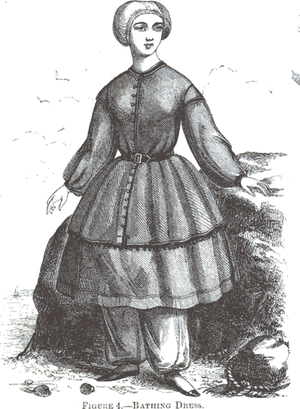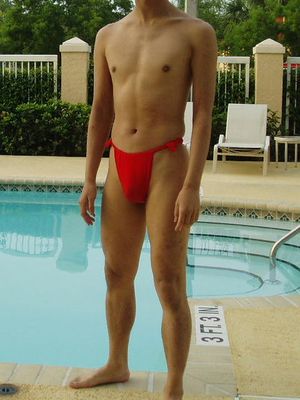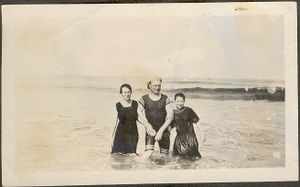Swimsuit
A swimsuit, bathing suit, or swimming costume is an item of clothing designed to be worn while engaging in a water-based activity or water sports, such as swimming, water polo, diving, surfing, water skiing, or during activities in the sun, such as sunbathing. A swimsuit can also be worn as an undergarment in sports that require a wetsuit such as water skiing, scuba diving, surfing, and wakeboarding. Swimsuits are also worn when there is a need to display the body, as in the case of beauty pageants, or bodybuilding contests. Glamour photography and magazines like Sports Illustrated's annual "swimsuit issue" feature models and sports personalities in swimsuits.
In New Zealand English, swimsuits are rarely called anything other than togs or, less usually, bathers. They are less commonly called "cossies". The term "togs" is less common in other parts of the Commonwealth, where it can also refer to clothes in general.
Body coverage
Swimsuits can be skin-tight or loose-fitting. They are often lined with another layer of fabric if the outer fabric becomes transparent when wet.
Swimsuits range from designs that almost completely cover the body to designs that expose almost all of the body. The choice of swimsuit will depend on personal and community standards of modesty and on considerations such as how much or how little sun protection is desired, and prevailing fashions. Almost all swimsuits cover the genitals and pubic hair, while most except thongs cover much or all of the buttocks. Most swimsuits in western culture leave at least the head, shoulders, arms, and lower part of the leg (below the knee) exposed. Women's swimsuits generally cover at least the areola and bottom half of the breasts, but some are designed for the top part of the swimsuit to be removed. In many countries, young girls and sometimes women choose not to wear a swimsuit top, and this can vary with the occasion, location, age, etc. Men's swimsuits which cover the upper body are relatively rare in western culture.
Both men and women may sometimes wear swimsuits covering more of the body when swimming in cold water (see also wetsuit and dry suit). In colder temperatures, swimwear is needed to conserve body heat and protect the body core from hypothermia.
History
In Classical antiquity swimming and bathing were done nude. There are Roman murals that show women playing sports and exercising wearing two-piece suits covering the areas around their breasts and hips in a fashion remarkably similar to a bikini of ca. 1960. However, there is no evidence that this was used for swimming. All classical pictures of swimming show nude swimmers.
In various cultural traditions, one swims, if not in the nude, in a version in suitable material of a garment or undergarment commonly worn on land, e.g. a loincloth such as the Japanese man's fundoshi (see photo at right).
In the United Kingdom until the mid-19th century, there was no law against nude swimming, with each town being free to make its own laws. For example, the Bath Corporation of Somerset official bathing dress code of 1737 prescribed, for men:
- It is Ordered Established and Decreed by this Corporation that no Male person above the age of ten years shall at any time hereafter go into any Bath or Baths within this City by day or by night without a Pair of Drawers and a Waistcoat on their bodies.
In rivers, lakes, streams, and the sea, men swam in the nude, where the practice was common. Those who didn't swim in the nude, stripped to their underwear. The English practice of men swimming in the nude was banned in the United Kingdom in 1860. Drawers, or caleçons as they were called, came into use in the 1860s. Even then there were many who protested against them and wanted to remain in the nude. Francis Kilvert described men's bathing suits coming into use in the 1870s as "a pair of very short red and white stripped drawers".
Female bathing costumes were derived from those worn at Bath and other spas. It would appear that until the 1670s nude female bathing in the spas was the norm and that after that time women bathed clothed. Celia Fiennes gave a detailed description of the standard ladies' bathing costume in 1687:
- The Ladyes go into the bath with Garments made of a fine yellow canvas, which is stiff and made large with great sleeves like a parson’s gown; the water fills it up so that it is borne off that your shape is not seen, it does not cling close as other linning, which Lookes sadly in the poorer sort that go in their own linning. The Gentlemen have drawers and wastcoates of the same sort of canvas, this is the best linning, for the bath water will Change any other yellow.
The Bath Corporation official bathing dress code of 1737 prescribed, for women:
- No Female person shall at any time hereafter go into a Bath or Baths within this City by day or by night without a decent Shift on their bodies.
The Expedition of Humphrey Clinker was published in 1771 and its description of ladies’ bathing costume is different to that of Celia Fiennes a hundred years earlier:
- The ladies wear jackets and petticoats of brown linen, with chip hats, in which they fix their handkerchiefs to wipe the sweat from their faces; but, truly, whether it is owing to the steam that surrounds them, or the heat of the water, or the nature of the dress, or to all these causes together, they look so flushed, and so frightful, that I always turn my eyes another way.
Penelope Byrde points out that Smollett’s description may not be accurate, for he describes a two-piece costume, not the one-piece shift or smock that most people describe and is depicted in contemporary prints. His description does, however, tally with Elizabeth Grant’s description of the guide’s costume at Ramsgate in 1811. The only difference is in the fabric the costumes are made of. Flannel, however, was a common fabric for sea bathing costumes as many believed the warmer fabric was necessary in cold water.
In the 18th century women wore "bathing gowns" in the water; these were long dresses of fabrics that would not become transparent when wet, with weights sewn into the hems so that they would not rise up in the water. The men's swim suit, a rather form-fitting wool garment with long sleeves and legs similar to long underwear, was developed and would change little for a century.
In the 19th century, the woman's two-piece suit became common-the two pieces being a gown from shoulder to knees plus a set of trousers with leggings going down to the ankles.
In the Victorian era, popular beach resorts were commonly equipped with bathing machines designed to avoid the exposure of people in swimsuits, especially to people of the opposite sex.
In the United States, beauty contests of women in bathing costumes became popular in the 1880s. However, such contests were not regarded as respectable. Beauty contests became more respectable with the first modern "Miss America" contest held in 1921, though less respectable beauty contests continued to be held.
In 1907 the swimmer Annette Kellerman from Australia visited the United States as an "underwater ballerina", a version of synchronized swimming involving diving into glass tanks. She was arrested for indecent exposure because her swimsuit showed arms, legs, and the neck. Kellerman changed the suit to have long arms and legs and a collar, still keeping the close fit that revealed the shapes underneath. She later starred in several movies, including one about her life.
[[Image:BathingMachineDontBeAfraid.jpg|thumb|left|200px|Man and woman in swimsuits, ca. 1910; she is exiting a bathing machine
After this, bathing wear started to shrink, first uncovering the arms and then the legs up to mid-thigh. Collars receded from around the neck down to around the top of the bosom. The development of new fabrics allowed for new varieties of more comfortable and practical swimwear.
Due to the figure-hugging nature of these garments, glamour photography since the 1940s and 1950s has often featured people wearing swimsuits. This subset of glamour photography eventually evolved into swimsuit photography exemplified by the Sports Illustrated annual swimsuit issues.
The first bikinis were introduced just after World War II. Early examples were not very different from the women's two pieces common since the 1920s, except that they had a gap below the breast line allowing for a section of bare midriff. They were named after Bikini Atoll, the site of several nuclear weapons tests, for their supposed explosive effect on the viewer.
Through the 1950s, it was thought proper for the lower part of the bikini to come up high enough to cover the navel. From the 1960s on, the bikini shrank in all directions until it sometimes covered little more than the nipples and genitalia, although less revealing models giving more support to the breasts remained popular. At the same time, fashion designer Rudi Gernreich introduced the monokini, a topless suit for women consisting of a modest bottom supported by two thin straps. Although not a commercial success, the suit opened my eyes to new design possibilities. In the 1980s the thongs or "tanga" came out of Brazil, said to have been inspired by traditional garments of native tribes in the Amazon River Basin. However, the one-piece suit continued to be popular for its more modest approach.
Men's swimsuits developed roughly in parallel to women's during this period, with the shorts covering progressively less. Eventually, racing-style "speedo" suits became popular and not just for their speed advantages. Thongs, G-strings, and bikini style suits are also worn, typically these are more popular in more tropical regions; however, they may also be worn in public swimming pools and inland lakes. But in the 1990s, longer and baggier shorts became popular, with the hems often reaching to the knees. These were often worn lower on the hips than regular shorts.
Alternatives to swimsuits
Some women prefer to engaging in water or sun activities with the torso uncovered. The practice is often described as "toplessness" or "topfreedom". Some people prefer not to wear any swimsuit when engaging in such activities. In some places around the world, nude beaches have been set aside for people who choose to engage in normal beach activities in the nude.
As an alternative to a swimsuit, some people wear trousers, underpants or a T-shirt either as a make-shift swimsuit or because they prefer regular clothes over swimsuits. In some countries, such as Thailand, swimming in regular clothes is the norm while swimsuits are rare. At beaches, this may be more accepted than at swimming pools, which tend not to permit the practice because underwear is unlined, may become translucent, and may be perceived as unclean.
| Sports related topics |
|---|
Chat rooms • What links here • Copyright info • Contact information • Category:Root



